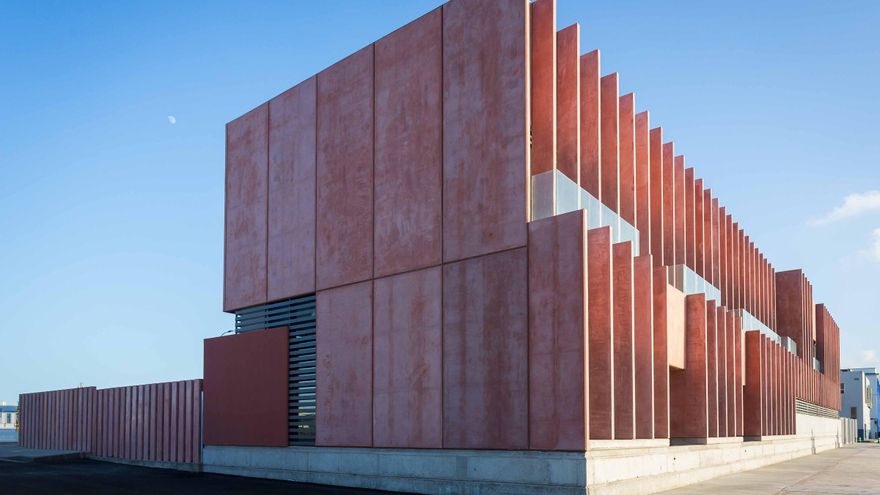
Eight architectural works in the archipelago have been selected for the Awards Architecture 2025, which is celebrating its fourth edition. Among the 201 chosen proposals throughout the national territory is the new headquarters of the Civil Guard in Puerto de la Luz in Las Palmas de Gran Canaria. This building, designed by Boissier Architects, focuses on sustainability and low energy consumption. On the same island, specifically in Santa Brígida, there’s an interior design project executed by Bluma Architects that renovated the Lola Massieu Hall in the Palacio de Congresos de Infecar, in line with heritage conservation, modernization, and accessibility.
In total, 456 proposals were submitted, which were evaluated by specialised committees established in the Colleges and Autonomous Councils of Architects. From this selection, there are 123 works in the building category, 16 in dissemination, 30 in urban planning, and 12 in interior design.
The fishing dock housing the Civil Guard headquarters, falling into the first category, is noted for its bioclimatic performance that achieves high comfort levels without energy consumption. This construction also consolidates the Customs, fiscal, and surveillance services of this security force in one location.
Rehabilitation and Accessibility
Meanwhile, the work on the exhibition hall Lola Massieu falls under the category of rehabilitation, merging the enhancement of historical elements like the Table of the Council of Ministers with technological features and functional design. The introduced modifications aim to improve space preservation as well as accessibility, including renovations made to the bathrooms.
On Tenerife, five other projects were selected, one being the rehabilitation of the Tabacos Factory and Cinema Victoria by Fagd Study. This iconic Santa Crulero building, which now houses a supermarket, had minimal environmental regulations affecting the factory’s facade, while the cinema portion had no protection whatsoever.
This intervention revitalised both properties that had been closed since 1975. The restoration of unprotected elements and the recovery of degraded structural and decorative features like signage, woodwork, locks, or stained glass were all part of the process.
Sustainability and Beauty
Next, the Hidden House in La Laguna involved an intervention in the edification category, using techniques that naturally connect the spaces, allowing the building to integrate harmoniously with its surroundings. The project, led by MAKIN AND MOLOWNY ARCHITECTS, SLP, beautifully combines sustainability and aesthetics.
Regarding the Centre of Aquatic Sports in Tenerife, located in La Cruz port, Gestur Canary Islands SA undertook works in the building category that promote efficient resource use and a sustainable bioclimatic design fostering social interaction. It also incorporates principles of urban rehabilitation and regeneration, all while maintaining functionality.
In Costa Adeje, there’s another selected project, specifically the renewal of the Mirador de la Paloma, undertaken by Jiménez Bazán Architects. The goals of this project included creating an accessible route and replanting plant species that were once present in the area, among other initiatives.
Renaturalisation of the Territory
Included among the projects on Tenerife is also the strategy for renaturalising urban hydrological channels in the capital. This plan, put together by Rodrigo Vargas González, takes a multidisciplinary approach that spans design, planning, and territorial management, all aimed at enhancing habitability and restoring public and natural spaces.
Finally, Fuerteventura has also made the list of selected projects. It features the POLIVAL BUILDING, situated in the island’s Technology Park, developed by Boissier Architects. This building employs natural light for all areas and implements a natural ventilation strategy.
The list of selected projects comprises 21 proposals from Andalusia, eight from Aragon, five from Asturias, five from Cantabria, eight from Castilla-La Mancha, 16 from Castilla y León, 30 from Catalonia, six from Extremadura, 11 from Galicia, eight from the Balearics, eight from the Canary Islands, five from La Rioja, 31 from Madrid, one from Melilla, seven from Murcia, 14 from Navarre, and the Basque Country, as well as 17 from the Valencian Community, according to the territorial distribution outlined by the award’s guidelines. Twelve projects are built outside Spain.
















